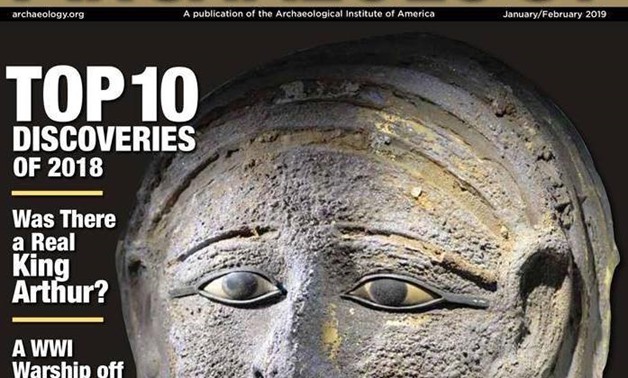
Cover of January/February 2019 Archaeology Magazine issue
CAIRO – 28 December 2018: The mummification workshop that was discovered in Saqqara in July was selected by Archaeology Magazine as one of the magazine’s top ten archaeological discoveries of 2018.
The Magazine is featuring the gilded silver mask that was discovered on the mummification workshop on the cover of its January/February 2019 issue.
Minister of Antiquities Khaled el-Anany announced on Saturday, July 14 in an international press conference the discovery of a mummification workshop and a communal burial place, dating to the Saite-Persian Period (664-404 B.C.) at the Saqqara Necropolis.
The discovery was unveiled south of King Unas' Pyramid in Saqqara by an Egyptian-German mission from the Tübingen University. The mission also found a gilded sliver mummy mask in one of the burial chambers of the main shaft attached to the mummification workshop.
The mask belonged to the Second Priest of Mut and Niut-shaes and measures 23 x 18.5 cm. The initial microscopic examination indicated that the mask is made of gilded silver, calcite and obsidian and contains a black precious stone, most probably black onyx.
The toupee was also inlayed with gemstones that were once embedded in colour pastes. A research and conservation project is currently being planned for the mask.
“The importance of such a discovery lies in its relevance to an important issue that the whole world is concerned with, which is mummification with its methods of embalming, workshops and tools,” Anany recounted in the press conference.
Ramadan Badry Hussein, director of Saqqara Saite Tombs Project and Professor at Tübingen University, announced that this discovery is considered a unique one.
According to Hussein, the discovered mummification workshop is a rectangular building of mud brick and irregular limestone blocks; it has an entrance on the south-western corner that leads to an open area with two large basins and a mud brick ramp between them. The two basins are surrounded with mud brick walls and are believed to have been used for the preparation of linen bandages.
Hussein recounted that the mummification workshop includes an embalmer’s cachette with a 13 meter deep shaft that ends with a rectangular subterranean chamber, where a large number of pottery vessels, bowls and measuring cups used for keeping mummification oils and materials were found.
Additionally, a large shaft used as a communal burial place was found in the middle of the mummification workshop. Shaft number K24 comprises several burial chambers, including a complex of burial chambers cut into the bedrock at a depth of 30 meters.
The burial chambers are arranged on the sides of two inlets. The first inlet has an intact burial chamber on the west, where three decayed wooden coffins were found at the western end of a large limestone sarcophagus, a fourth mummy was found to the north of that sarcophagus and a large number of ushabti figurines were also found along the northern side of the sarcophagus.
Hussein further pointed out that the middle wooden coffin is badly damaged, and the mummy inside it had a gilded mask. The wooden coffin was once plastered and painted with an image of the goddess Nut, the mother of the god of the dead, Osiris.
The decorations on the coffin also include the titles of the owner of the mask along with his name. The owner is the Second Priest of the goddess Mut and the Priest of the goddess Niut-shaes, a serpent form of the goddess Mut. The theophoric name of the owner of the mask includes the name of the goddess Neith, the patron goddess of Dynasty 26. Pieces of the painted plaster carrying the rest of his name are still missing, and the mission is searching for them in order to read the full name of the deceased.
Head of the supreme council of Antiquities Mostafa Waziry previously announced that the importance of this discovery lies in that it was found in Saqqara, a site that has not been visited by an archaeological mission since 1900.
Waziry explained that the well in which the workshop is located is connected to another well that is expected to be uncovered during the upcoming period.
The magazine stated that there was a familial dispute between a wife and her mother-in-law over the mummy of the husband/son who is buried in this burial chamber. Most probably the mother was not satisfied with the burial of her son in this shaft. Another burial chamber included an uncle and his nephew, while the third contained the sarcophagus of a wealthy woman, called Tadihor.
The discovered gilded silver mask, the first found in Saqqara since 1905 and in Egypt since 1939, has inlayed calcite, obsidian and onyx eyes, and measures 23 by 18.5 cm.
Gilded silver masks had deep religious meaning, since Egyptian religious texts indicate that the bones of the gods are made of silver, and their flesh/skin are made of gold. Therefore, a mummy mask of silver and gold is step towards the transformation of the deceased into a god.
The Egyptian-German team is expected to open the four sealed large sarcophagi in the burial chambers of Tadihor, Iauet, Ayput and Tjanimit in the spring and winter of 2019, expecting more discoveries.

Comments
Leave a Comment